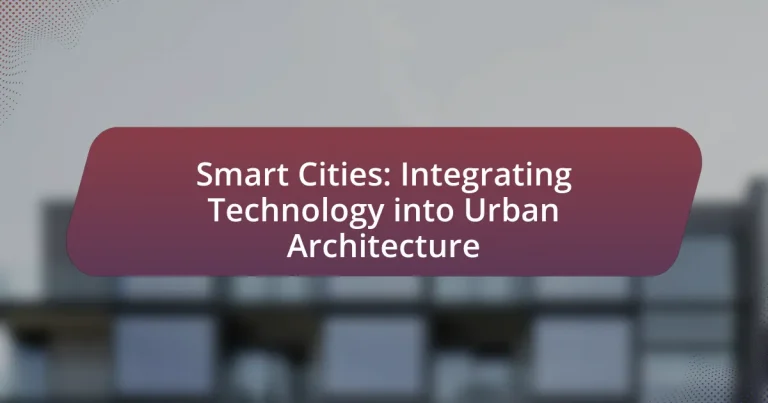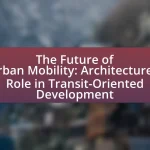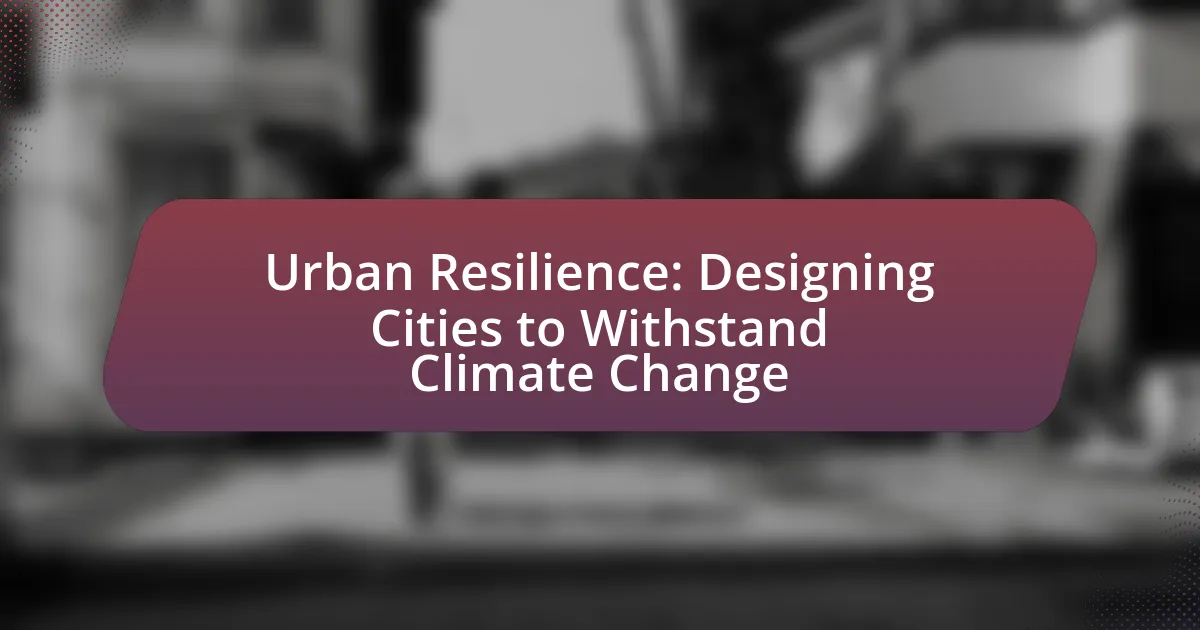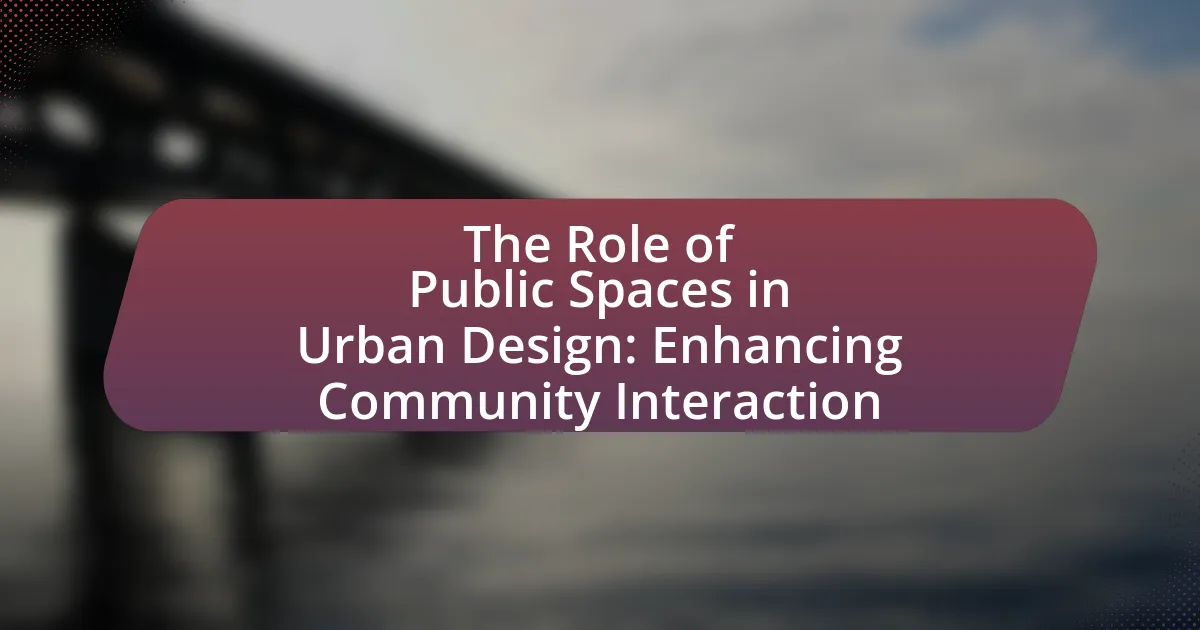Smart cities are urban areas that leverage digital technology and data analytics to enhance the quality of life for residents, improve infrastructure, and optimize resource management. This article explores the definition and characteristics of smart cities, highlighting their integration of technologies such as IoT devices, AI, and data analytics into urban architecture. It discusses the benefits of smart cities, including increased efficiency, sustainability, and improved public services, while also addressing challenges such as data privacy and funding limitations. Additionally, the article examines future trends in smart city development and best practices for successful technology integration, emphasizing the importance of community engagement and stakeholder collaboration.
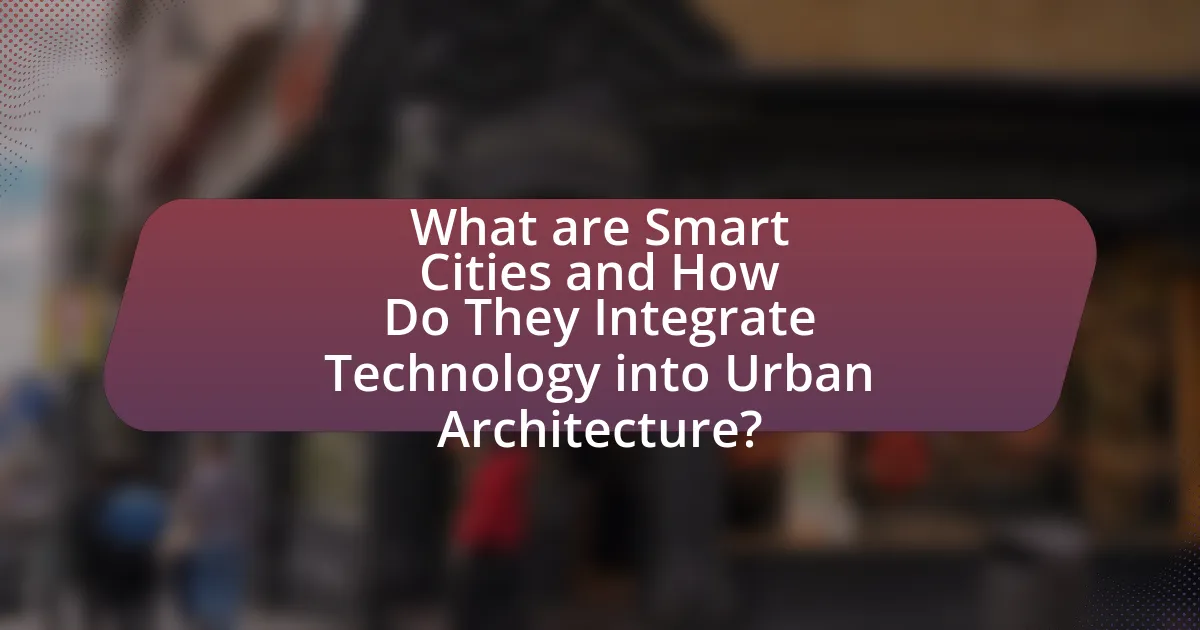
What are Smart Cities and How Do They Integrate Technology into Urban Architecture?
Smart cities are urban areas that utilize digital technology and data analytics to enhance the quality of life for residents, improve infrastructure, and optimize resource management. They integrate technology into urban architecture through the implementation of smart grids, IoT devices, and data-driven decision-making processes. For instance, smart lighting systems adjust based on real-time data, reducing energy consumption, while smart traffic management systems use sensors to optimize traffic flow, thereby decreasing congestion. According to a report by the International Telecommunication Union, smart city initiatives can lead to a 30% reduction in energy consumption and a 20% decrease in traffic congestion, demonstrating the effectiveness of technology integration in urban environments.
What defines a Smart City?
A Smart City is defined as an urban area that utilizes digital technology and data analytics to enhance performance, improve efficiency, and provide better services to its citizens. This integration of technology includes the use of sensors, IoT devices, and data management systems to optimize resources such as energy, transportation, and public safety. For instance, according to the International Telecommunication Union, Smart Cities leverage information and communication technology (ICT) to improve the quality of life for residents while promoting sustainable development.
What are the key characteristics of Smart Cities?
Smart Cities are characterized by the integration of advanced technology, data analytics, and sustainable practices to enhance urban living. These cities utilize Internet of Things (IoT) devices to collect real-time data, which informs decision-making and improves services such as transportation, energy management, and public safety. For instance, cities like Barcelona and Singapore have implemented smart traffic management systems that reduce congestion and emissions, demonstrating the effectiveness of technology in urban planning. Additionally, Smart Cities prioritize citizen engagement through digital platforms, allowing residents to participate in governance and service delivery, thereby fostering a sense of community and transparency.
How do Smart Cities differ from traditional urban areas?
Smart Cities differ from traditional urban areas primarily through their integration of advanced technology and data analytics to enhance urban living. Smart Cities utilize Internet of Things (IoT) devices, sensors, and data-driven solutions to optimize services such as transportation, energy management, and public safety, resulting in improved efficiency and sustainability. For instance, a study by the International Telecommunication Union indicates that Smart Cities can reduce energy consumption by up to 30% through smart grids and efficient resource management. In contrast, traditional urban areas often rely on outdated infrastructure and manual processes, leading to inefficiencies and higher operational costs.
How is technology integrated into urban architecture?
Technology is integrated into urban architecture through the use of smart building systems, sustainable materials, and data-driven design. Smart building systems utilize sensors and automation to optimize energy efficiency, enhance security, and improve occupant comfort. For example, buildings equipped with IoT devices can monitor energy consumption in real-time, allowing for adjustments that reduce waste and lower costs. Additionally, sustainable materials such as recycled steel and green roofs are increasingly used to minimize environmental impact. Data-driven design leverages analytics to inform urban planning decisions, ensuring that infrastructure meets the needs of the population effectively. This integration of technology not only enhances the functionality of urban spaces but also contributes to the overall sustainability and livability of cities.
What types of technologies are commonly used in Smart Cities?
Smart cities commonly utilize technologies such as Internet of Things (IoT) devices, big data analytics, artificial intelligence (AI), and smart grids. IoT devices enable real-time data collection and communication between various urban systems, enhancing efficiency in areas like traffic management and waste disposal. Big data analytics processes vast amounts of information to inform decision-making and improve city services. AI algorithms optimize resource allocation and predictive maintenance, while smart grids facilitate efficient energy distribution and consumption. These technologies collectively contribute to improved urban living conditions and sustainability.
How does technology enhance urban infrastructure?
Technology enhances urban infrastructure by improving efficiency, sustainability, and connectivity within cities. Smart sensors and IoT devices enable real-time monitoring of traffic, energy usage, and waste management, leading to optimized resource allocation. For instance, cities utilizing smart traffic lights can reduce congestion by adjusting signal timings based on real-time traffic conditions, which has been shown to decrease travel times by up to 30%. Additionally, technologies like GIS (Geographic Information Systems) facilitate better urban planning by providing data-driven insights into land use and population density, allowing for more informed decision-making. These advancements contribute to the overall resilience and livability of urban environments.
What are the challenges faced in creating Smart Cities?
Creating Smart Cities faces several challenges, including technological integration, data privacy concerns, and funding limitations. Technological integration involves the difficulty of harmonizing various systems and platforms, which can lead to inefficiencies and increased costs. Data privacy concerns arise from the extensive data collection required for smart technologies, raising issues about security and individual privacy rights. Funding limitations often hinder the implementation of smart city projects, as substantial investment is necessary for infrastructure upgrades and technology deployment. According to a report by the McKinsey Global Institute, cities may need to invest up to $57 trillion in infrastructure by 2030 to support urbanization and smart city initiatives, highlighting the financial challenges involved.
What are the technological barriers to Smart City development?
Technological barriers to Smart City development include inadequate infrastructure, data privacy concerns, and interoperability issues. Inadequate infrastructure, such as outdated communication networks, limits the deployment of advanced technologies like IoT devices. Data privacy concerns arise from the collection and management of vast amounts of personal data, leading to public resistance and regulatory challenges. Interoperability issues occur when different systems and technologies fail to communicate effectively, hindering seamless integration and functionality. These barriers collectively impede the progress and effectiveness of Smart City initiatives.
How do social and economic factors impact Smart City initiatives?
Social and economic factors significantly impact Smart City initiatives by influencing funding, community engagement, and technology adoption. Economic conditions determine the availability of resources for infrastructure development and technology investments, as cities with stronger economies can allocate more funds towards Smart City projects. For instance, cities like Singapore have leveraged their economic strength to implement advanced technologies in urban planning and public services.
Social factors, including public perception and community involvement, shape the success of these initiatives. High levels of community engagement can lead to better alignment of Smart City projects with residents’ needs, as seen in Barcelona, where citizen participation has guided the development of smart solutions. Conversely, social inequality can hinder access to technology and services, limiting the overall effectiveness of Smart City initiatives.
Thus, the interplay of economic resources and social dynamics is crucial for the successful implementation and sustainability of Smart City projects.
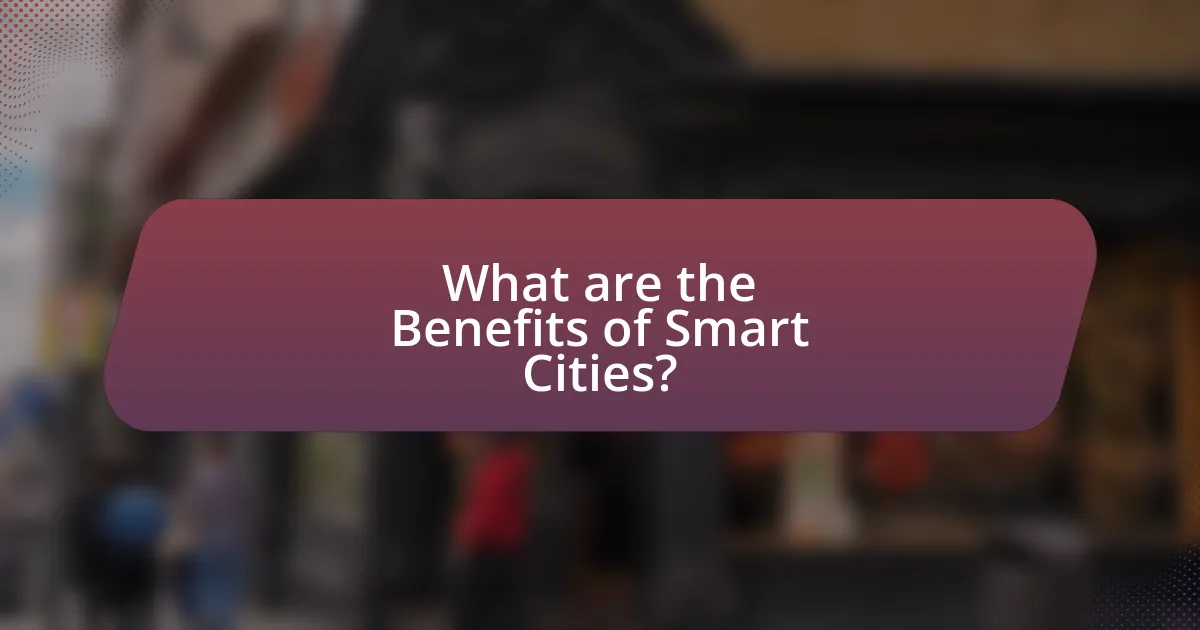
What are the Benefits of Smart Cities?
Smart cities enhance urban living by improving efficiency, sustainability, and quality of life. They utilize technology to optimize resource management, such as energy and water, leading to reduced waste and lower costs. For instance, smart grids can decrease energy consumption by up to 30%, as reported by the U.S. Department of Energy. Additionally, smart cities promote better transportation systems through real-time data, reducing traffic congestion and emissions. According to a study by McKinsey, implementing smart transportation solutions can cut travel times by 15-20%. Furthermore, smart cities improve public safety through advanced surveillance and emergency response systems, contributing to a safer urban environment. Overall, the integration of technology in urban architecture fosters a more connected, efficient, and livable city.
How do Smart Cities improve quality of life for residents?
Smart Cities improve quality of life for residents by leveraging technology to enhance urban services and infrastructure. These cities utilize data analytics and Internet of Things (IoT) devices to optimize traffic management, reduce energy consumption, and improve public safety. For instance, smart traffic lights can adjust in real-time to traffic flow, reducing congestion and commute times, which has been shown to decrease travel time by up to 30% in some urban areas. Additionally, smart waste management systems can monitor waste levels and optimize collection routes, leading to cleaner neighborhoods and reduced operational costs. Furthermore, enhanced connectivity through high-speed internet access allows residents to engage in remote work and access online services more efficiently, contributing to overall well-being.
What role does technology play in enhancing public services?
Technology plays a crucial role in enhancing public services by improving efficiency, accessibility, and responsiveness. For instance, the implementation of digital platforms allows citizens to access services online, reducing wait times and streamlining processes. According to a report by the McKinsey Global Institute, cities that adopt smart technologies can improve public service efficiency by up to 30%. Additionally, data analytics enables governments to make informed decisions, optimize resource allocation, and respond more effectively to community needs. This integration of technology not only enhances service delivery but also fosters greater citizen engagement and satisfaction.
How do Smart Cities promote sustainability and environmental health?
Smart Cities promote sustainability and environmental health by utilizing advanced technologies to optimize resource management and reduce environmental impact. These cities implement smart grids for efficient energy distribution, which can lead to a reduction in greenhouse gas emissions by up to 30% as reported by the International Energy Agency. Additionally, Smart Cities employ IoT sensors to monitor air quality and traffic patterns, enabling real-time adjustments that minimize congestion and pollution. For instance, cities like Barcelona have integrated smart waste management systems that increase recycling rates and decrease landfill use, contributing to a cleaner urban environment. Furthermore, the use of green infrastructure, such as permeable pavements and urban green spaces, enhances biodiversity and improves stormwater management, thereby promoting overall ecological health.
What economic advantages do Smart Cities offer?
Smart Cities offer significant economic advantages, including increased efficiency in resource management and enhanced economic growth through innovation. By utilizing advanced technologies such as IoT and data analytics, Smart Cities optimize energy consumption, reduce waste, and improve transportation systems, leading to cost savings for both municipalities and residents. For instance, a study by the McKinsey Global Institute found that smart city technologies could generate up to $1.6 trillion in economic value annually by 2025 through improved productivity and reduced operational costs. Additionally, Smart Cities attract businesses and investments by providing a modern infrastructure that supports innovation and enhances the quality of life, further driving economic development.
How do Smart Cities attract businesses and investments?
Smart Cities attract businesses and investments by leveraging advanced technologies to enhance urban infrastructure and improve quality of life. These cities implement smart solutions such as IoT devices, data analytics, and sustainable energy systems, which create efficient environments for businesses to operate. For instance, cities like Barcelona and Singapore have integrated smart traffic management and energy-efficient buildings, resulting in reduced operational costs and increased productivity for companies. Additionally, the presence of a skilled workforce and improved connectivity in Smart Cities further incentivizes businesses to invest, as evidenced by the influx of tech companies in cities that prioritize innovation and sustainability.
What is the impact of Smart Cities on job creation?
Smart Cities significantly enhance job creation by fostering innovation and attracting investments in technology and infrastructure. The integration of smart technologies leads to the development of new sectors, such as data analytics, IoT services, and sustainable energy solutions, which create diverse employment opportunities. For instance, a report by the McKinsey Global Institute indicates that smart city initiatives could generate up to 1.5 million jobs in the United States alone by 2030, driven by advancements in urban mobility, energy efficiency, and public safety. This job growth is further supported by the need for skilled workers to implement and maintain smart technologies, thereby transforming urban economies and improving overall employment rates.
How do Smart Cities foster community engagement?
Smart Cities foster community engagement by utilizing technology to enhance communication and participation among residents. Through platforms such as mobile apps and social media, Smart Cities enable citizens to provide feedback on urban planning, report issues, and participate in local decision-making processes. For instance, cities like Barcelona have implemented digital tools that allow residents to vote on community projects, thereby increasing civic involvement. Additionally, data-driven insights from sensors and analytics help local governments understand community needs better, leading to more tailored services and initiatives that resonate with residents. This approach not only empowers citizens but also strengthens the sense of community by fostering collaboration and transparency in governance.
What technologies facilitate citizen participation in urban planning?
Technologies that facilitate citizen participation in urban planning include Geographic Information Systems (GIS), mobile applications, online platforms, and social media. GIS allows citizens to visualize spatial data and engage in mapping exercises, enhancing their understanding of urban issues. Mobile applications enable real-time feedback and reporting on local conditions, while online platforms provide forums for discussion and collaboration among community members. Social media serves as a tool for outreach and engagement, allowing urban planners to gather public opinions and foster dialogue. These technologies collectively enhance transparency and inclusivity in the urban planning process, leading to more informed decision-making.
How do Smart Cities address social equity and inclusion?
Smart Cities address social equity and inclusion by leveraging technology to enhance access to services and resources for all community members. These cities implement data-driven solutions to identify and address disparities in public services, such as transportation, healthcare, and education. For instance, smart public transportation systems use real-time data to optimize routes and schedules, ensuring that underserved areas receive adequate service. Additionally, initiatives like digital literacy programs and affordable broadband access aim to bridge the digital divide, empowering marginalized populations to participate fully in the digital economy. Evidence from various Smart City projects shows that inclusive planning and community engagement lead to more equitable outcomes, as seen in cities like Barcelona, which has prioritized citizen input in urban development.
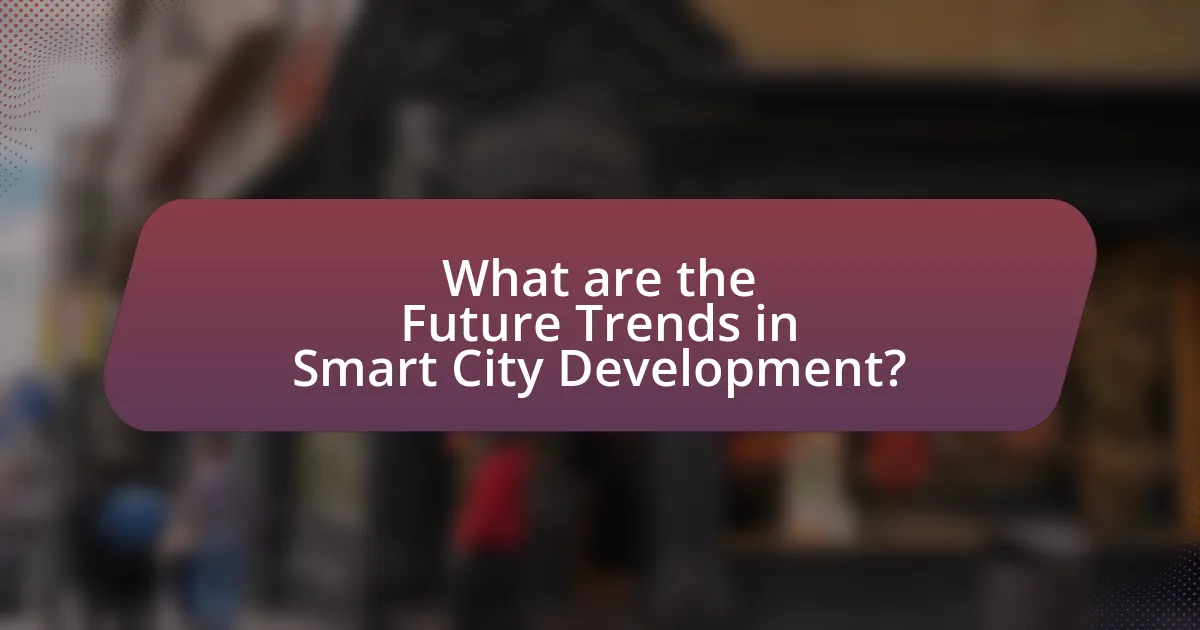
What are the Future Trends in Smart City Development?
Future trends in smart city development include the integration of artificial intelligence, enhanced data analytics, and sustainable infrastructure. Cities are increasingly adopting AI to optimize traffic management, improve public safety, and enhance citizen engagement through smart applications. Data analytics is being utilized to analyze urban patterns, enabling better resource allocation and service delivery. Additionally, sustainable infrastructure, such as green buildings and renewable energy sources, is becoming a priority to reduce carbon footprints and promote environmental resilience. According to the International Data Corporation, global spending on smart city initiatives is projected to reach $189.5 billion by 2023, highlighting the growing investment in these technologies.
How is artificial intelligence shaping Smart Cities?
Artificial intelligence is shaping Smart Cities by enhancing urban management, optimizing resource allocation, and improving citizen engagement. AI technologies, such as machine learning and data analytics, enable cities to analyze vast amounts of data from sensors and IoT devices, leading to more efficient traffic management, energy consumption, and waste management. For instance, cities like Barcelona utilize AI to optimize traffic flow, reducing congestion by up to 30% through real-time data analysis. Additionally, AI-driven platforms facilitate better communication between city officials and residents, allowing for more responsive governance and improved public services.
What are the implications of AI on urban management?
AI significantly enhances urban management by optimizing resource allocation, improving service delivery, and enabling data-driven decision-making. For instance, AI algorithms can analyze traffic patterns to reduce congestion, leading to more efficient public transportation systems. Additionally, AI-powered predictive analytics can forecast urban growth and infrastructure needs, allowing city planners to proactively address challenges. A study by the McKinsey Global Institute highlights that AI could potentially create up to $13 trillion in economic value by 2030, underscoring its transformative impact on urban environments.
How can AI improve public safety in Smart Cities?
AI can improve public safety in Smart Cities by enhancing surveillance, predictive policing, and emergency response systems. For instance, AI-powered cameras can analyze real-time data to detect unusual activities, enabling law enforcement to respond swiftly to potential threats. Additionally, predictive analytics can identify crime hotspots based on historical data, allowing for proactive deployment of resources. A study by the National Institute of Justice found that cities using AI for predictive policing experienced a 20% reduction in crime rates. Furthermore, AI can optimize emergency response by analyzing traffic patterns and predicting the fastest routes for emergency vehicles, thereby reducing response times and potentially saving lives.
What role does data play in the evolution of Smart Cities?
Data is fundamental to the evolution of Smart Cities as it enables informed decision-making, enhances operational efficiency, and improves the quality of urban life. By collecting and analyzing data from various sources such as sensors, social media, and public services, city planners can identify trends, optimize resource allocation, and address urban challenges effectively. For instance, a study by the McKinsey Global Institute found that data-driven urban management could reduce traffic congestion by up to 30%, demonstrating the tangible benefits of leveraging data in urban environments.
How is big data utilized for urban planning and decision-making?
Big data is utilized for urban planning and decision-making by providing insights through the analysis of vast datasets related to demographics, traffic patterns, and environmental conditions. Urban planners leverage this information to optimize resource allocation, enhance infrastructure development, and improve public services. For instance, cities like Barcelona and Singapore use real-time data analytics to monitor traffic flow and adjust public transport schedules accordingly, resulting in reduced congestion and improved commuter experiences. Additionally, predictive analytics derived from big data helps in forecasting urban growth and identifying areas in need of development, thereby facilitating informed decision-making that aligns with sustainable urban development goals.
What are the privacy concerns associated with data collection in Smart Cities?
Privacy concerns associated with data collection in Smart Cities include unauthorized surveillance, data breaches, and the potential misuse of personal information. The integration of technologies such as sensors and cameras can lead to constant monitoring of individuals, raising fears about civil liberties and the right to anonymity. For instance, a report by the Electronic Frontier Foundation highlights that cities employing facial recognition technology may inadvertently profile and track citizens without their consent. Additionally, data breaches can expose sensitive information, as evidenced by incidents where municipal databases have been compromised, leading to identity theft and other privacy violations. These concerns underscore the need for robust data protection regulations and transparency in how data is collected and used in urban environments.
What are best practices for implementing Smart City technologies?
Best practices for implementing Smart City technologies include engaging stakeholders, ensuring data privacy, and adopting an iterative approach. Engaging stakeholders, such as residents, businesses, and government entities, fosters collaboration and ensures that the technologies meet community needs. Ensuring data privacy is crucial, as cities collect vast amounts of personal information; compliance with regulations like GDPR can protect citizens’ rights. Adopting an iterative approach allows for continuous improvement based on feedback and evolving technologies, which is essential for long-term success. These practices are supported by case studies from cities like Barcelona and Singapore, which have successfully integrated Smart technologies while prioritizing community involvement and data security.
How can cities ensure successful technology integration?
Cities can ensure successful technology integration by establishing clear strategic plans that align technology initiatives with urban development goals. This involves engaging stakeholders, including residents, businesses, and government agencies, to identify needs and priorities. For instance, cities like Barcelona have implemented smart city strategies that focus on citizen participation and data-driven decision-making, resulting in improved public services and infrastructure. Additionally, investing in robust digital infrastructure, such as high-speed internet and IoT networks, is crucial for supporting various technologies. According to a report by McKinsey, cities that prioritize digital infrastructure can enhance operational efficiency and citizen engagement, leading to more sustainable urban environments.
What strategies can be employed to engage stakeholders effectively?
To engage stakeholders effectively in the context of smart cities, strategies such as inclusive communication, collaborative decision-making, and leveraging technology for transparency should be employed. Inclusive communication ensures that all stakeholders, including residents, businesses, and government entities, are informed and have a voice in the planning process. Collaborative decision-making fosters partnerships among stakeholders, allowing for shared ownership of projects and initiatives. Leveraging technology, such as digital platforms for feedback and data sharing, enhances transparency and builds trust among stakeholders. Research indicates that cities that actively involve stakeholders in the planning and implementation of smart technologies see higher satisfaction and better outcomes, as evidenced by case studies from cities like Barcelona and Amsterdam, which have successfully integrated stakeholder engagement into their urban development strategies.
